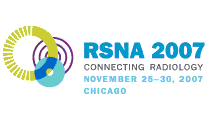
Abstract Archives of the RSNA, 2007
SSM06-01
Non-value of Unenhanced CT in Patients with Suspected Liver Metastasis When Scanning Time for Enhanced MDCT Is Determined by Tracking Attenuation of Liver Parenchyma during IV Contrast Injection
Scientific Papers
Presented on November 28, 2007
Presented as part of SSM06: Gastrointestinal (Liver: Focal Lesions)
Alessia Tognolini MD, Presenter: Research grant, Toshiba Corporation, Tustin, CA
Milliam Lika Kataoka MD, Abstract Co-Author: Nothing to Disclose
Girish Tyagi MD, Abstract Co-Author: Nothing to Disclose
Carol J. Wilcox, Abstract Co-Author: Nothing to Disclose
Carl O'Donnell MPH, Abstract Co-Author: Nothing to Disclose
Vassilios D. Raptopoulos MD, Abstract Co-Author: Research grant, Toshiba Corporation, Tustin, CA
Research grant, E-Z-EM, Inc, Lake Success, NY
To re-evaluate the need for unhenanced scan in patients with suspected metastatic liver disease if parenchymal enhancement tracking is used to trigger timing of IV-contrast enhanced scanning.
Out of 400 consecutive CT scans of patients with suspected metastatic liver disease, 97 patients were selected based on the following exclusion criteria: normal CT, cirrhosis or neuroendocrine primar (multiphase scanning), previous lesion ablation or chemoembolization. Primary tumors sites included 36 GI tract,20 breast,12 urinary tract,10 melanoma,8 lung, 5 pancreas and 6 GYN. Two observers jointly reviewed the scans and identified liver lesions in unenhanced and enhanced scans separately. For reference we used the combined series. Up to 5 lesions per patient were selected.If >5 lesions per liver,lesions within 3 slices above and 3 below portal hilum were included. 4-,8-,16- and 64-row MDCT scanners were used. 120-150 ml IV contrast was given, at 2.5 mL/sec. Scanning was triggered by monitoring liver enhancement (50 HU above baseline for GE) or attenuation (100 HU for Toshiba, or 80 sec, whatever came first.Lesion conspicuity was measured as liver-to-lesion attenuation difference.
266 lesions were detected (187 mets,18 cysts,5 hemangiomas and 56 “too small to characterize”): 107 were >1cm and 159 ≤1cm .Mean lesion conspicuity was significantly greater on contrast-enhanced scans:53±29 HU vs. 22±14 HU in unenhances scans (p<0.001). 182 lesions were seen in both series,79 in contrast-enhanced only and 5 in unenhansed scans only. Of the latter,all were < 1 cm and none was the only liver lesion.Compared to the unehanced scans, significantly more lesions were seen on the enhanced series: 187 vs. 261 (p<0.001). Per lesion sensitivity of contrast-enhanced scans was 98% (CI, 95%-99%.)
In patients with suspected hypovascular metastatic liver disease,unenhanced scans have ho value if timing of contrast-echanced MDCT is determined by liver parenchyma tracking.
To eliminate the need for unhenanced scan to reduce dose exposure in patients with multiple MDCT follow ups
Tognolini, A,
Kataoka, M,
Tyagi, G,
Wilcox, C,
O'Donnell, C,
Raptopoulos, V,
Non-value of Unenhanced CT in Patients with Suspected Liver Metastasis When Scanning Time for Enhanced MDCT Is Determined by Tracking Attenuation of Liver Parenchyma during IV Contrast Injection. Radiological Society of North America 2007 Scientific Assembly and Annual Meeting, November 25 - November 30, 2007 ,Chicago IL.
http://archive.rsna.org/2007/5013615.html

